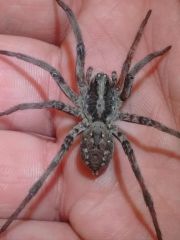Carolina Wolf Spider
The Carolina Wolf Spider (Hogna carolinensis)
Common Names: Wolf Spider, Carolina Wolf Spider,
Size
This is the largest wolf spider in North America! The body length of males is typically 19 mm (0.75 in), and the body length of females is typically around 25 millimetres (0.98 in).
Taxonomic Hierarchy
→ Kingdom: Animalia → Phylum: Arthropoda → Class: Arachnida → Order: Araneae → Family: Lycosidae → Genus: Hogna → Species: Hogna carolinensisPronunciation: HAWG-nuh kair-oh-ly-NEN-sis
Identifying Traits
The usual coloration of these spiders can vary, the same way the skin color of us humans can vary in color as well, but they are usually a ghostly grey with white and black markings, and have black banding on the underside of each of their legs; a couple key traits can aid in their identification: their size (although size alone is not a good trait to identify any spider with), their orange-ish yellow chelicerae (jaws), their eye arrangement which is specific to all wolf spiders and by the undersides of their cephalothorax and abdomen, which are both jet black.
Specimens of H. carolinensis are distinguished by large body, carapace with median and submarginal bands weakly developed; sternum, leg coxae, and abdominal venter black. Tips of femora III & IV and bases of tips of tibiae III & IV black. Some of these characteristics are found in different combinations in a few other Wolf Spiders, such as the Schizocosa genus, which is a smaller spider in stature but with just as big an appetite.
Is The Carolina Wolf Spider Dangerous? The old saying that they are more afraid of us than we typically are to them is especially true with spiders, especially considering that they are not vampiric creatures such as ticks, leeches and mosquitoes---they do not drink blood---and thus have no reason to bite us humans for any other reason other than defense. And even if you were to be bitten, their venom is not regarded as medically significant and isn't usually anything to be worried about; keeping the bite clean and perhaps applying a bit of ice should be more than sufficient to treat a bite from this spider.
Preying Methods
Hogna carolinensis, like most---if not all spiders---lack a pair of ears but has excellent vision. The hairs and that cover its body are quite sensitive and can easily detect the motion of a nearby prey item as it comes near, alerting the Wolf Spider to its presence. With its incredible speed, most prey items are unable to escape, and once caught the fight is all but over as the Carolina Wolf is by far one of the stronger true spiders on the planet. They can easily capture and overpower other bugs that are quite large and powerful themselves, such as large grasshoppers, praying mantises and and even vertebrates. Although Wolf Spiders do have the ability to spin silk, they do not build webs and instead actively hunt their food on foot, stalking, ambushing and overpowering them and delivering a very powerful bite, injecting venom into their dinner. As with the venom of all spiders, the venom of H. carolinensis helps to liquefy the insides, making it easier for the spider to draw in through its fangs to be digested. Carolina Wolf Spiders build retreats, such as holes or tunnels in the soil; under and between boards, stones, and firewood; under siding; and in similarly undisturbed areas.Interesting Fact: In 2000, the Carolina wolf spider was declared the official state spider of South Carolina.
Mating
Visual and Vibration signals are given out by the male wolf spider are important in attracting the mate. Signals are made by the male by raising their legs or bouncing their body. Females are more than likely to mate with the male if they perform larger leg movements and body shakes. The vibration signals are more crucial than the visual signal ( as the visual ones are not enough to interest the females). In different environments the male signals sent out by the male spider can be altered to better attract a mate. The visual and vibration signals sent out by the male wolf spider are more effective in leaves with the rate of success attracting females to be 85%. The visual and vibratory signal that a male wolf spider sends out allows the female to determine stamina and fitness level.Reproduction
Spiderlings of this species are born in June or July and reach approximately half of their full size before the following winter sets in; they will "overwinter" to emerge in early spring and, if they survive, will attain their full size by around mid-summer. The mating process takes place in fall, with the males usually dying before the onset of winter of the same year, while females are commonly documented to survive for many years after reaching maturity. After mating, the females will generally dig out a burrow that can sometimes reach up to eight inches where they will line it with silk and cover the opening with debris for added safety and seclusion. She will lay around 100-150 eggs here and build a silken sac around them to be carried on her back until they hatch; wolf spiders are the only known species of spider to carry their young on their back until they can fend for themselves.Habitats
Locating these spiders is much easier at night, as they are nocturnal, and also because of one of the many things that make wolf spiders so interesting: reflective tapetum, or eyeshine. Although it is a myth that only Lycosidae species exhibit this, they tend to have brighter reflections from their eyes due to there two very large middle-set, forward-looking eyes. A great way to locate Hogna carolinensis---or ANY Wolf Spider, for that matter---is to take with you a bright flashlight or headlamp and looking for this conspicuous give-away. Headlamps tend to be more efficient in spotting these spiders due to their placement close to the spider hunter's eyes, allowing the beams of light from the reflective tapetum to be reflected directly along the same path as the beam emanating from the headlamp, and thus into the hunter's eyes.Side Note: Spiders, in general, especially to the individual that is not educated on these animals, tend to be very intimidating---almost evil---in the way they look and move. But spiders, again, in general, are usually anything but, and are rarely in the mood to attack anything other than their prey items; they are not the evil critters that the vast majority of the population makes them out to be, and the Carolina Wolf, its size, speed and voracious appetite notwithstanding, is no exception to that rule...they are easily handleable and very often kept as pets. More often than not they flee from any other bug or animal that is larger than them, and this includes humans.
Location: Hogna carolinensis exists in all US States save Alaska and Hawaii, but does extend into Canada and south into Mexico.
References: Wikipedia, Bug Guide, SpiderzRule, Spiders.US
Links:
PennState Entomology: ( http://ento.psu.edu/extension/factsheets/wolf-spiders)
PetBugs.com: (http://www.petbugs.com/caresheets/H-carolinensis.html),
InsectIdentification.org:(http://www.insectidentification.org/insect-description.asp?identification=Carolina-Wolf-Spider) EntomologyDiary: (http://entomologydiary.typepad.com/home/carolina-wolf-spider-hogna-carolinensis-araneae-lycosidae.html)


